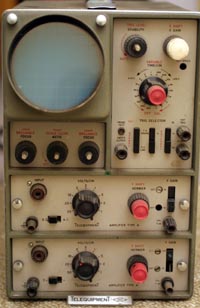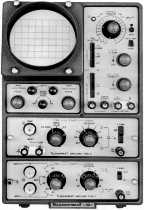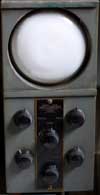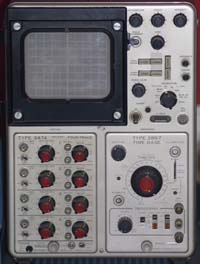 A small, valve (vacuum tube) oscilloscope intended for use in
schools and colleges.
It's single channel, uncalibrated and has no provision for
external sync or timebase.
The date in the manual is 1966.
A small, valve (vacuum tube) oscilloscope intended for use in
schools and colleges.
It's single channel, uncalibrated and has no provision for
external sync or timebase.
The date in the manual is 1966.
| Scrapheap Scopes |
My old scopes, some of which have actually been saved from the scrapheap.
 A small, valve (vacuum tube) oscilloscope intended for use in
schools and colleges.
It's single channel, uncalibrated and has no provision for
external sync or timebase.
The date in the manual is 1966.
A small, valve (vacuum tube) oscilloscope intended for use in
schools and colleges.
It's single channel, uncalibrated and has no provision for
external sync or timebase.
The date in the manual is 1966.
The oldest Telequipment model I have, and even the rectifier is valve. The ‘R’ suffix indicates that this is a rack-mounting scope, and the ‘D’ prefix indicates dual-beam.
Most of these scopes are dual-beam but, unlike modern scopes, they have two separate electron guns inside the tube, each with its own pair of vertical deflection plates. They also have two brightness and two focus controls. Modern dual-beam scopes have just a single electron gun and use a multiplexing technique to produce two traces on the screen (you sometimes see a “chop/alternate” button).
Another special feature of these old scopes is the timebase stability control. You had to tweak it just right to get the timebase to run.
 Slightly more modern version of the Telequipment scope,
this time in a benchtop case.
Again, dual-beam with two electron guns.
This example has clearly seen better days, with several controls knobs missing and
a faulty timebase.
Slightly more modern version of the Telequipment scope,
this time in a benchtop case.
Again, dual-beam with two electron guns.
This example has clearly seen better days, with several controls knobs missing and
a faulty timebase.
 Perhaps the ultimate development in valve scopes,
the “43” system was a range of scopes with
interchangeable plug-in modules.
My copy of the manual is version 2.5, dated November 1968 and
mentions that Telequipment is a member of the
Tektronix group.
Perhaps the ultimate development in valve scopes,
the “43” system was a range of scopes with
interchangeable plug-in modules.
My copy of the manual is version 2.5, dated November 1968 and
mentions that Telequipment is a member of the
Tektronix group.
 The dual-beam models would accept any two vertical amplifier modules and there was also a
choice of timebase modules. Not only are there two brightness and focus controls, there are also
two astigmatism controls.
Unlike modern dual-beam scopes, the D43's tube has two electron guns
and actually produces two beams of electrons.
Nowadays, tubes only have one gun and the beam is switched electronically
between channel A and channel B.
This is done either on alternate sweeps of the timebase (ALT mode)
or by a separate oscillator (CHOP mode).
The dual-beam models would accept any two vertical amplifier modules and there was also a
choice of timebase modules. Not only are there two brightness and focus controls, there are also
two astigmatism controls.
Unlike modern dual-beam scopes, the D43's tube has two electron guns
and actually produces two beams of electrons.
Nowadays, tubes only have one gun and the beam is switched electronically
between channel A and channel B.
This is done either on alternate sweeps of the timebase (ALT mode)
or by a separate oscillator (CHOP mode).
I have two of these scopes, one of which has a long-persistance phosphor in the CRT and a special slow timebase. The special phosphor glows blue when struck by the electron beam, but the decaying trace is orange. An orange filter then tones down the brightness of the spot while leaving the afterglow unaffected, so you just increase the brightness in order to get the long-persistence effect.

 This fine old scope was rescued from a sad fate at the local
dump in Weston-Super-Mare.
It is remarkable in that it contains only three valves, and
one of those is the rectifier!
It's in quite poor condition, and
I've never dared to apply power and see if it works.
Cossor is now part of
Raytheon Electronic Systems.
This fine old scope was rescued from a sad fate at the local
dump in Weston-Super-Mare.
It is remarkable in that it contains only three valves, and
one of those is the rectifier!
It's in quite poor condition, and
I've never dared to apply power and see if it works.
Cossor is now part of
Raytheon Electronic Systems.
 A digitally-controlled analog scope!
It has an IEEE-488
(HP-IB)
interface to allow the scope to be controlled by a computer.
Internally, the scope has an
8085
CPU to control all its functions
and to send and receive data on the IEEE interface.
The scope was introduced by HP in 1980.
A digitally-controlled analog scope!
It has an IEEE-488
(HP-IB)
interface to allow the scope to be controlled by a computer.
Internally, the scope has an
8085
CPU to control all its functions
and to send and receive data on the IEEE interface.
The scope was introduced by HP in 1980.
I have two of these scopes, and one of them has a couple of optional extras installed. The first is the 19860 Digital Waveform Storage Option, which allows the scope to digitise a waveform and store it in a memory (two separate memories are provided). The second option is the 19811A Plot/Sequence ROM, which allows the scope to drive an HPGL plotter through the IEEE-488 interface in order to plot stored waveforms. It also adds a sort of "keyboard macro" capability to speed up repetitive test sequences. I'm looking for a manual for the 19860 option, as well as a plug-in expansion module, HP part number 1950B, to turn the scope into a four-channel version.
 I acquired this scope from the University of Bath, complete with
scope trolley and camera.
It's an analog storage scope, which means that it has a special
cathode-ray tube (CRT) which can store an image without the need for
the scope to refresh it.
Like modern digital storage scopes, it is used to display waveforms that
occur only once and do not repeat.
It is fitted with plug-in modules for both vertical amplifier and
timebase, similar in principle to the Telequipment scopes.
The vertical amplifier module is a four-channel type and includes
some
Nuvistors, tiny miniature valves with
metal cases.
Tektronix still manufactures storage
scopes, but nowadays they are digital and have liquid-crystal displays.
I acquired this scope from the University of Bath, complete with
scope trolley and camera.
It's an analog storage scope, which means that it has a special
cathode-ray tube (CRT) which can store an image without the need for
the scope to refresh it.
Like modern digital storage scopes, it is used to display waveforms that
occur only once and do not repeat.
It is fitted with plug-in modules for both vertical amplifier and
timebase, similar in principle to the Telequipment scopes.
The vertical amplifier module is a four-channel type and includes
some
Nuvistors, tiny miniature valves with
metal cases.
Tektronix still manufactures storage
scopes, but nowadays they are digital and have liquid-crystal displays.
Tek 564 on the Tek Wiki.
3A74 Four-Channel Y Amplifier plug-in on the Tek Wiki.
2B67 Timebase plug-in on the Tek Wiki.
My most recent Tek acquision, a transistorised scope from the 5000 series.
It is fitted with plug-in modules for both vertical amplifier and
timebase, although I only have one Y amplifier whereas the scope
has three module slots in all.
The vertical amplifier module is a two-channel type and was the location
of the shorted tantalum capacitor that caused the original fault.
Tektronix still manufactures
scopes, but nowadays they are digital and have liquid-crystal displays.
 This scope uses the same tiny electrostatic-deflection CRT as the
Sinclair Microvision pocket TV.
It's a single-trace, battery-operated portable scope.
It runs on four C-size batteries, or an external mains adaptor.
This scope uses the same tiny electrostatic-deflection CRT as the
Sinclair Microvision pocket TV.
It's a single-trace, battery-operated portable scope.
It runs on four C-size batteries, or an external mains adaptor.
Return to the Old Sad Things page
Return to John Honniball's home page
Copyright © 1997-2012 by John Honniball. All rights reserved.